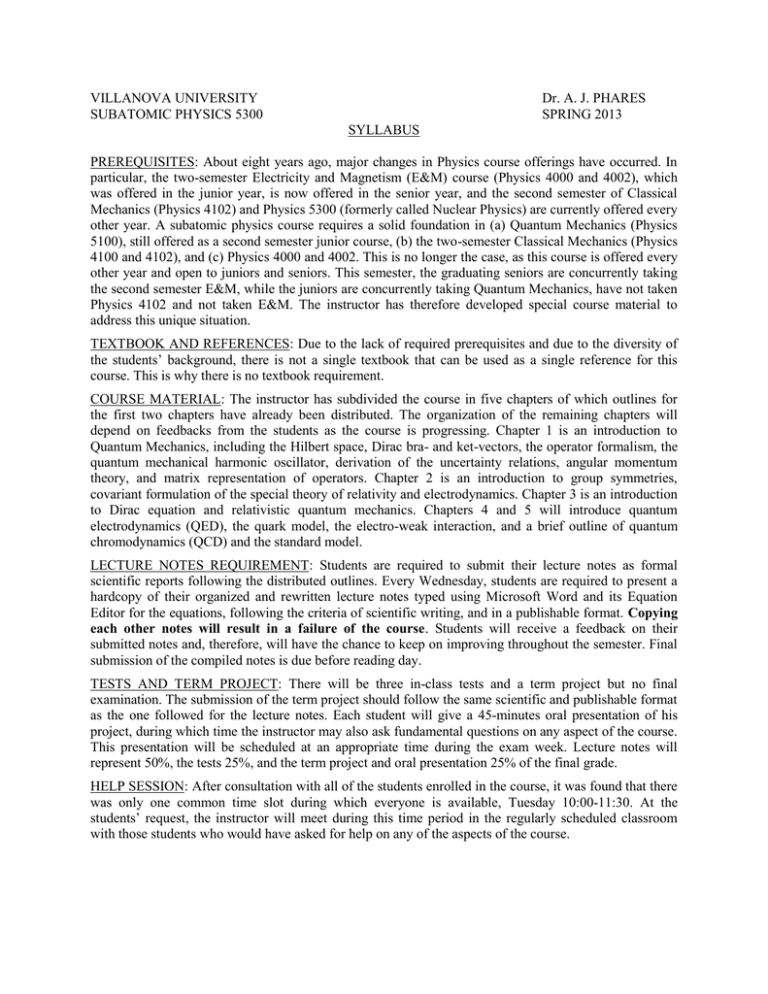5300 Subatomic Physics.doc
advertisement

VILLANOVA UNIVERSITY SUBATOMIC PHYSICS 5300 Dr. A. J. PHARES SPRING 2013 SYLLABUS PREREQUISITES: About eight years ago, major changes in Physics course offerings have occurred. In particular, the two-semester Electricity and Magnetism (E&M) course (Physics 4000 and 4002), which was offered in the junior year, is now offered in the senior year, and the second semester of Classical Mechanics (Physics 4102) and Physics 5300 (formerly called Nuclear Physics) are currently offered every other year. A subatomic physics course requires a solid foundation in (a) Quantum Mechanics (Physics 5100), still offered as a second semester junior course, (b) the two-semester Classical Mechanics (Physics 4100 and 4102), and (c) Physics 4000 and 4002. This is no longer the case, as this course is offered every other year and open to juniors and seniors. This semester, the graduating seniors are concurrently taking the second semester E&M, while the juniors are concurrently taking Quantum Mechanics, have not taken Physics 4102 and not taken E&M. The instructor has therefore developed special course material to address this unique situation. TEXTBOOK AND REFERENCES: Due to the lack of required prerequisites and due to the diversity of the students’ background, there is not a single textbook that can be used as a single reference for this course. This is why there is no textbook requirement. COURSE MATERIAL: The instructor has subdivided the course in five chapters of which outlines for the first two chapters have already been distributed. The organization of the remaining chapters will depend on feedbacks from the students as the course is progressing. Chapter 1 is an introduction to Quantum Mechanics, including the Hilbert space, Dirac bra- and ket-vectors, the operator formalism, the quantum mechanical harmonic oscillator, derivation of the uncertainty relations, angular momentum theory, and matrix representation of operators. Chapter 2 is an introduction to group symmetries, covariant formulation of the special theory of relativity and electrodynamics. Chapter 3 is an introduction to Dirac equation and relativistic quantum mechanics. Chapters 4 and 5 will introduce quantum electrodynamics (QED), the quark model, the electro-weak interaction, and a brief outline of quantum chromodynamics (QCD) and the standard model. LECTURE NOTES REQUIREMENT: Students are required to submit their lecture notes as formal scientific reports following the distributed outlines. Every Wednesday, students are required to present a hardcopy of their organized and rewritten lecture notes typed using Microsoft Word and its Equation Editor for the equations, following the criteria of scientific writing, and in a publishable format. Copying each other notes will result in a failure of the course. Students will receive a feedback on their submitted notes and, therefore, will have the chance to keep on improving throughout the semester. Final submission of the compiled notes is due before reading day. TESTS AND TERM PROJECT: There will be three in-class tests and a term project but no final examination. The submission of the term project should follow the same scientific and publishable format as the one followed for the lecture notes. Each student will give a 45-minutes oral presentation of his project, during which time the instructor may also ask fundamental questions on any aspect of the course. This presentation will be scheduled at an appropriate time during the exam week. Lecture notes will represent 50%, the tests 25%, and the term project and oral presentation 25% of the final grade. HELP SESSION: After consultation with all of the students enrolled in the course, it was found that there was only one common time slot during which everyone is available, Tuesday 10:00-11:30. At the students’ request, the instructor will meet during this time period in the regularly scheduled classroom with those students who would have asked for help on any of the aspects of the course.


